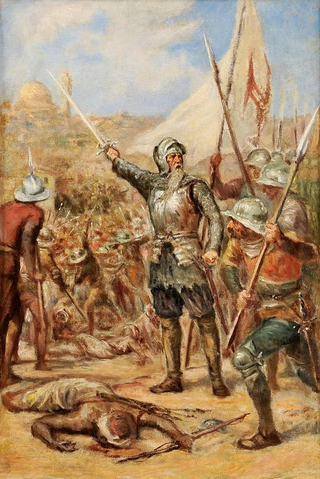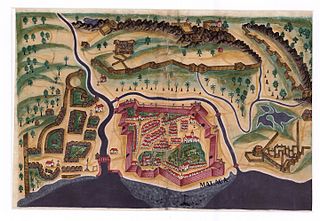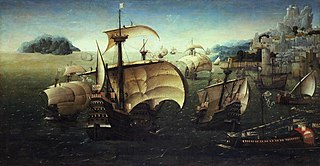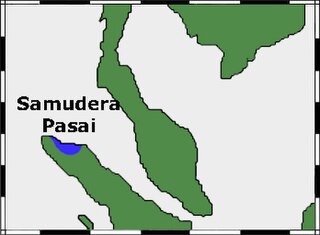
Afonso de Albuquerque, 1st Duke of Goa, was a Portuguese general, admiral, and statesman. He served as viceroy of Portuguese India from 1509 to 1515, during which he expanded Portuguese influence across the Indian Ocean and built a reputation as a fierce and skilled military commander.
Sultan Alauddin Riayat Shah II ibni Almarhum Sultan Mahmud Shah was the first sultan of Johor. He ruled Johor from 1528 to 1564. He founded the Johor Sultanate following the fall of Malacca to the Portuguese in 1511. He was the second son of Mahmud Shah of Malacca. Thus, Johor was a successor state of Malacca and Johor's sultans follow the numbering system of Malacca. Throughout his reign, he faced constant threats from the Portuguese as well as the emerging Aceh Sultanate.

Dutch Malacca (1641–1825) was the longest period that Malacca was under foreign control. The Dutch ruled for almost 183 years with intermittent British occupation during the Napoleonic Wars (1795–1815). This era saw relative peace with little serious interruption from the Malay sultanates due to the understanding forged between the Dutch and the Sultanate of Johor in 1606. This time also marked the decline of the importance of Malacca. The Dutch preferred Batavia as their economic and administrative centre in the region and their hold in Malacca was to prevent the loss of the city to other European powers and, subsequently, the competition that would come with it. Thus, in the 17th century, with Malacca ceased to be an important port, the Johor Sultanate became the dominant local power in the region due to the opening of its ports and the alliance with the Dutch.

Portuguese control of Malacca, a city on the Malay Peninsula, spanned the 130 year period (1511–1641) when it was a possession of the Portuguese East Indies. It was conquered from the Malacca Sultanate as part of Portuguese attempts to gain control of trade in the region. Although multiple attempts to conquer it were repulsed, the city was eventually lost to an alliance of Dutch and regional forces, thus entering a period of Dutch rule.

The Ottoman–Portuguese Conflicts (1586–1589) were armed military engagements which took place between the Portuguese Empire and the Ottoman Empire along the coast of eastern Africa. The conflict resulted from the expansion of the Portuguese Empire into territory controlled by the Adal Sultanate.

The Capture of Malacca in 1511 occurred when the governor of Portuguese India Afonso de Albuquerque conquered the city of Malacca in 1511.

China–Portugal relations, can be traced back all the way to 1514 during the Ming dynasty of China. Relations between the modern political entities of the People's Republic of China and the Portuguese Republic officially began on 2 February 1979. China and Portugal established the comprehensive strategic partnership in 2005.
The Battle of Sincouwaan, also known as Battle of Veniaga Island was a naval battle between the Ming dynasty coast guard and a Portuguese fleet led by Martim Afonso de Mello that occurred in 1522. The Ming court threatened to expel Portuguese traders from China after receiving news that the Malacca Sultanate, a Ming tributary, had been invaded by the Portuguese. In addition, the Portuguese had been purchasing slaves on the Chinese coast, to sell in Portuguese Malacca. Portuguese traders were executed in China and a Portuguese embassy was arrested, with their freedom promised on the condition that the Portuguese returned Malacca to its sultan. Martim Afonso de Mello arrived at the Pearl River but was blockaded by a Ming fleet despite his offers of amends. After two weeks without being able to gain a foothold in China they decided to run the blockade and managed to escape with the loss of two ships and several dozen men. The battle was fought off the northwestern coast of Lantau Island, Hong Kong at a location called Sai Tso Wan today.

The Battle of Duyon River was a naval engagement between the Portuguese forces commanded by Nuno Álvares Botelho, who is renowned in Portugal as one of the last great commanders of Portuguese India, and the forces of the Sultanate of Aceh, which were led by Lassemane.
The Battle of Aceh was fought in 1569 off the coast of Sumatra between a lone Portuguese carrack and an armada of the Sultanate of Aceh, that was about to stage an attack on Portuguese Malacca. It ended in Portuguese victory and the withdrawal of the Aceh fleet after suffering heavy losses.

The War of the League of the Indies was a military conflict in which a pan-Asian alliance formed primarily by the Sultanate of Bijapur, the Sultanate of Ahmadnagar, the Kingdom of Calicut, and the Sultanate of Aceh, referred to by the Portuguese historian António Pinto Pereira as the "league of kings of India", "the confederated kings", or simply "the league", attempted to decisively overturn Portuguese presence in the Indian Ocean through a combined assault on some of the main possessions of the Portuguese State of India: Malacca, Chaul, Chale fort, and the capital of the maritime empire in Asia, Goa.
The siege of Johor of 1587 was a military operation in which Portuguese forces successfully sieged, sacked, and razed Johor, capital of its eponymous Sultanate. The city would later be rebuilt in a different location.
The Acehnese launched their invasion of Johor between 1613 and 1615 to subjugate and vassalize the Johor Sultanate, as part of the Acehenese expansion in the Malay peninsula under Iskandar Muda reign.
The Conquest of Perak was a military invasion launched by the Acehnese Sultanate to capture the port of Perak from its Sultan Mukaddam Shah of Perak, the attack was successful and its sultan was captured.

The Conquest of Pasai was a military campaign in 1523–1524 launched by the Sultanate of Aceh against the Samudera Pasai Sultanate and the Portuguese fortress there. The operation was a success for the Acehnese.

The Battle of Perlis River was an armed engagement that took place in 1547 within Perlis River, Malaysia, between a Portuguese fleet and a fleet of the Sultanate of Aceh. The Portuguese achieved "a complete victory" over the Acehnese fleet, which was almost completely destroyed.
The Battle of Formoso River of 1615 was an naval battle that took place in the Malay peninsula within Formoso River, between a Portuguese fleet and a large fleet of the Sultanate of Aceh, one of the largest Aceh had ever mobilized against the Portuguese in Malacca.

Malay-Portuguese conflicts refer to the military engagements between the forces of the Portuguese Empire and the various Malay states and dynasties, fought intermittently from 1509 to 1641 in the Malay Peninsula and Strait of Malacca.

Acehnese–Portuguese conflicts were the military engagements between the forces of the Portuguese Empire, established at Malacca in the Malay Peninsula, and the Sultanate of Aceh, fought intermittently from 1519 to 1639 in Sumatra, the Malay Peninsula or the Strait of Malacca. The Portuguese supported, or were supported, by various Malay or Sumatran states who opposed Acehnese expansionism, while the Acehnese received support from the Ottoman Empire.











